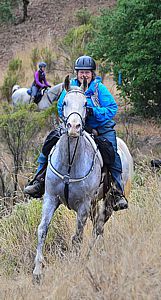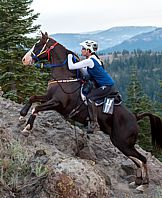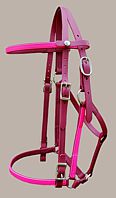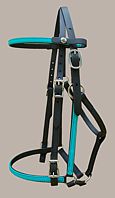Endurance Newsletter
Home Page
by
Gail Hought |
|
|
|
The Endurance Newsletters below are listed
with the newest on top. Included are small photo promotions.
If you have read a newsletter and you want to see it again, the
photos might help you find it.
If you are interested in being part of
such a newsletter or have any suggestions, please let me know.
hought@hought.com
Sincerely, Gail |
|
|
|
Hought Endurance Newsletter #17-4
September 25, 2017
I am a minimalist in many ways when it
comes to my endurance horses. I do not wrap or use a poultice
on their legs after a ride because I like to watch and feel what
effect the ride had on their legs. Much can be learned
about the horse’s soundness by being mindful of the leg’s
normality before and after a ride.
I would seriously encourage riders to become thoroughly familiar
with their horse’s legs. Feel them carefully prior
to each ride to the point you know what each leg is like normally.
All horses are different, some are clean legged and some are
blemished, such as old scars or wind puffs. Feel them again
after a ride particularly if it is long and if any differences
are noted. Check again after a period of time, for example,
at an endurance ride when you check on your horse to see how
he/she is eating, take the time to feel and visually check the
legs.
Being mindful of the feel of a horse’s legs is especially
important when conditioning new horses. If I see any swelling
from riding after a conditioning ride, I back off, by giving
them a few days off and/or more slow walking rides. I
feel this is extremely important, not to push too soon.
You will know what your horse’s legs tend to show after
a ride only when they are well conditioned for an endurance ride
or have been ridden over a distance. Some horses have legs
that rarely swell or show much effect from being ridden or some
slightly stock up. What I mean by ‘stock up' is some
swelling in the ankles that goes away with a little walking.
I have had horses with both swelling and wind puffs.
Cali, Shaq and Maverick all have had wind puffs to varying degrees.
Cali and Shaq mainly had them on their hind ankles while Maverick
has them on all four. I do not recall Cali swelling at
all. Shaq would stock up a little when he stood after a
ride, but it would totally disappear if walked even 100 ft.
Maverick has always taken more walking. If he can be turned
loose, it is not a problem at all. This stocking up is
most always in the front ankles. Masada, Tempest, Hoppy
and Cielo all have had tight legs after an endurance ride.
The opinions in this newsletter and those to follow are my
own. They reflect what I have learned over the years.
The newsletters are written for your consideration only.
I hope you find them helpful as you participate in the wonderful
sport of endurance. Gail Hought AERC#3595 18,005 AERC miles
Thanks, Gail Hought

CC Maverick – Completing 5,000 miles
& 17,000 miles for myself at Lake Sonoma, 2015. |
|
|
Hought Endurance Newsletter #17-3
September 6, 2017
The very popular Deluxe Add-On in teal beta/black beta, stainless
steel hardware.
http://www.hought.com/add.on.hs-del1-reg.col.html
To view other color combinations see the
link below.
http://www.hought.com/abc-end.colorchoices.html
The photo below was taken by Katie Azevedo
in September 3rd. We look like we live in a jungle.
We are in the redwoods. My daughter, Sonia, and I are riding
full siblings, brother and sister, getting ready for the ride
this weekend at Cuneo Creek. It will be Sonia’s gelding
2nd LD. Katie is riding her new mule. Very
nice mule. Hope to see some of you this weekend.

Dear Fellow Riders,
The last 4 horses I have used for endurance have been started
by my husband Eric. He not only started them but trained
and, in some cases, rode them in their first LD’s.
With Tempest and Maverick he also rode them in their first 50’s. Since
these horses were new to the sport, we would begin these
early rides by waiting for the group to leave, often even leading
them out for a distance before mounting. The main point
was to keep the start as quiet as possible for the horse.
Cielo, my youngest horse, was easy to ride
out of camp mounted but I still started her later towards the
end of the pack because she was and is highly competitive and
I didn’t think she was ready and I wanted her to see as
few horses as possible. I only started warming her up with
the group after she had around 600 miles.
Early rides on any of my horses new to
endurance are as slow as I can get away with yet still finish
in time. I do not want them to think “race”.
I also trot very little downhill during these early rides, that
is until I feel their legs ready for it and mentally capable
of handling everything. By this I
mean they are willing to drink and eat along the trail.
My goal of 1500 miles, which includes both
training and endurance mile, is what I aim at before I feel I
can let them go faster. At this time, I start
picking up the pace. I feel I need to have control for
both myself and my horses. Depending on the ride, the pace
will vary. I do not want my horses to think we only
go fast or only slow.
There are rides I feel are not suitable
when ridden too fast because the terrain is especially hard on
the horse. Many times, now because of my age, I will choose
to go slower. I just want my horse to be agreeable and
sound, and looking forward to the next ride.
The
opinions in this newsletter and those to follow are my own.
They reflect what I have learned over the years. The newsletters
are written for your consideration only. I hope you find
them helpful as you participate in the wonderful sport of endurance.
Gail Hought AERC#3595 18,005 AERC miles
Thanks, Gail Hought |
|
|
|
Hought
Endurance Newsletter #17-2
August 28, 2017
Dear Fellow Riders,
The American Endurance Ride Conference, AERC, is the sanctioning
group for endurance riding. Its goal is, “To finish
is to win.” There are those who consider endurance
riding as a race, some choose to finish in the middle of the
pack while others choose to complete within the last 30 minutes
of the prescribed time.
New riders interested
in endurance often think they need an Arabian horse. Many
times that is true, but sometimes it is best to consider the
horse they already own. In most cases riders who want to
participate in endurance already have a horse that can get them
started. If their horse is sound, safe and in good condition
it is probably a good candidate.
Almost any breed
can complete a Limited Distance (LD) ride, 25 miles in 6 hours.
If the horse can easily complete a 10 mile ride with a combination
of walking and trotting, it is probably capable of completing
a LD. Often if a horse does a somewhat challenging trail
ride easily, endurance may be a possibility. When I say
easily, I do not mean the horse just wants to go fast.
You want to feel that it is physically easy for him. If,
on the other hand, the horse finds it difficult, riding endurance
may not be advisable for him.
If you are interested
in getting started, now would be a good time to begin learning
to take your horse’s pulse and to become familiar with the
feel of his legs, both before and after a ride, no
matter if that ride is for training or any other type of ride.
Endurance riding
will teach a rider more about their horse than any other single
discipline. It is an opportunity to learn about a horse’s
pulse, hydration, conditioning, proper tack fit, feeding, metabolic
recovery and much more.
In the future, these newsletters will cover a variety of endurance
subjects.
The
opinions in this newsletter and those to follow are my own.
They reflect what I have learned over the years. The newsletters
are written for your consideration only. I hope you find
them helpful as you participate in the wonderful sport of endurance.
Thanks, Gail Hought |
|
|
|
Newletter #17-1
Hought Endurance Newsletter #17-1
August 16, 2017
|
The Bill Gore photo above is of Tennessee
Lane and Auli Farwa (Far) going over Cougar Rock. They
were the winners of the Tevis cup this year. Far won the
Haggin Cup 2 years ago and it was his 8th Tevis completion.
I am proud to say he was wearing our tack. When Tenney ordered
this tack, she wanted it in Colorado colors: red, white, blue
and yellow. See details of this tack on this page.
red, white,
blue and yellow beta. |
 |
 |
The Bill Gore photo above is of Tennessee
Lane and Auli Farwa (Far) going over Cougar Rock. They
were the winners of the Tevis cup this year. Far won the
Haggin Cup 2 years ago and it was his 8th Tevis completion.
I am proud to say he was wearing our tack. When Tenney ordered
this tack, she wanted it in Colorado colors: red, white, blue
and yellow. See details of this tack on this page.
red, white,
blue and yellow beta.
Dear Fellow Riders,
Many of you have ask me questions about my thoughts about endurance
riding over the years, so I decided it might be time to share
some with you.
Since
1972, I have ridden endurance and have 18,000 miles. I
have not been a very competitive rider but my goals have been
mostly the longevity of my horses, to experience a variety of
rides and enjoy riding my horses. As a teenager,
I read about Levi Ride & Tie and the Tevis in the Western
Horseman Magazine and I always wanted to do them. My Ride
& Tie partner, Nita Fiadella, and I completed in 3 Levi Ride
& Ties and my daughter, Soni, and I completed one National
Ride & Tie Championship. Years later I completed Tevis
3 times on Kings Flash (Shaq). The nicest thing about this
is after wanting to do both these events neither were a disappointment
and I thoroughly enjoyed them.
One question
I have been asked is what I prefer in an endurance horse.
My answer: one with good substance, not too leggy for its height.
No matter the horse’s height, I feel a lower center of gravity
allows it to go up and down steep hills easier. I do not
mean long backed or short legged, but one with a good top
line, long sloping shoulders and a long hip and one without an
overly high neck placement. I want a horse with good bone,
reasonably straight legs and good strong feet, ideally, nice
even feet. One thing about conformation is not to get overly
critical because most horses are not perfect and, if you wait
for the horse with perfect conformation, you may be waiting an
awfully long time. Some things are more important than
others, such as good feet.
I want
a Tevis type horse even if I do not plan to do Tevis on him/her.
What that means is a horse that can maneuver tough terrain, do
well metabolically and be mentally able to deal with that type
of endurance course. I want a horse with a strong confident disposition,
brave and as smart as possible regardless of its gender or color.
My attempt to avoid grey horses hasn’t worked well.
I like greys, just not the increased chance of melanomas.
In the
future, these newsletters will cover a variety of endurance subjects.
The
opinions in this newsletter and those to follow are my own.
They reflect what I have learned over the years. The newsletters
are written for your consideration only. I hope you find
them helpful as you participate in the wonderful sport of endurance.
Thanks, Gail Hought |
|
|







